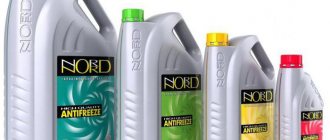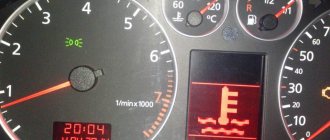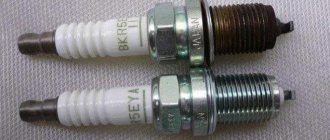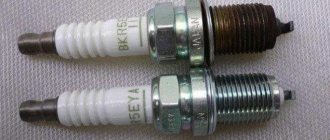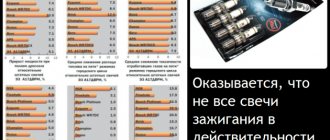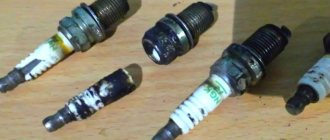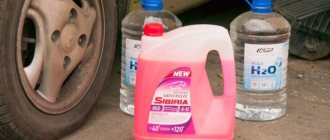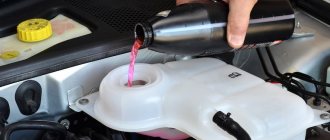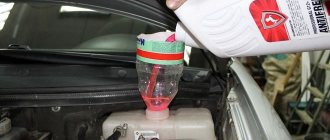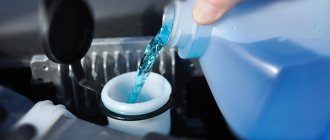In Europe and Russia, the VolksWagen classification applies:
- G11 - green
- G12 - red
- G13 - yellow, orange (formerly G12+), violet (compositions developed after 2012)
Choosing antifreeze only by color is wrong. While European and Japanese manufacturers still adhere to some kind of color system, Americans paint antifreeze as needed. Therefore, the first selection criterion should be the class of coolant.
In addition, modern antifreezes differ in the composition of their additives and can be: traditional, lobrid, carboxylate and hybrid.
Types of antifreeze, its color and recommendations for use
When it comes to antifreeze, their use, compatibility and operating rules for this product, you need to know that in domestic or world practice there are no specific standards regarding the compliance of any type of coolant with a particular color.
The color of the refrigerant is absolutely unrelated and does not affect its chemical composition or performance characteristics. Still, the color of the product will help tell about a number of its properties. By the color of the refrigerant you can learn about its auxiliary functions and choose the most necessary option for your car. So, let’s figure out what color of antifreeze a particular brand of car needs, whether water should be added to the coolant, and whether mixing different types of products is allowed.
Specifications
VOLKSWAGEN G13 antifreeze has the following characteristics:
| Identifier | Meaning |
| Brand | G13 |
| Color | Violet (Lilac) |
| Density at 20°C, kg/m3 | 1140 |
| Pour point, °C | -42 |
| Boiling point, °C at pressure 101.3 kPa, °C | 163 |
| Hydrogen value (pH) | 8,4 |
| Alkalinity, ml | 11,8 |
Under any load, the mixture does not evaporate and practically does not decrease.
What you need to know about antifreeze
To begin with, a small educational program. What is antifreeze? To put it simply, it is a liquid substance that the driver pours into the car’s cooling system. The main function of this product is to ensure reliable operation of the motor at any temperature. Antifreeze has a low freezing point, and due to this, the liquid prevents damage to parts and mechanisms, as if water were used for cooling. We all know from school physics lessons that at temperatures below zero degrees, water freezes, turns into ice, expands, and as a result, containers and pipes break down. When using antifreeze, even at the lowest temperatures, the likelihood of such malfunctions and breakdowns is practically eliminated.
Modern coolant can perform additional protective functions. It prevents rust from occurring on the surfaces of parts. Antifreeze, regardless of color, contains components such as ethylene glycol, in some cases propylene glycol, distilled water and a number of additives.
Product Description
Antifreeze Volkswagen G13 was developed specifically for the global German automaker in 2012.
The coolant is fundamentally different from all previously existing refrigerants. Antifreeze manufacturers take care of the safety of motorists and the environment. That is why the liquid does not contain a toxic ethylene glycol base. Engine coolant is absolutely harmless to humans and environmentally friendly. The composition contains a propylene glycol base.
Modern technologies have made it possible to produce antifreeze concentrate using organic acids, while eliminating silicate deficiencies. The concentrate has a non-standard purple color.
It has good anti-corrosion properties due to carboxylic acid additives. This means that not a single part of the cooling system will rust, will not be internally destroyed and will remain in working order throughout the entire service life of the antifreeze. The effect is on the most vulnerable areas, and not on the entire system. An invisible protective layer is formed on surfaces.
Volkswagen G13 has good heat transfer and cleans the system of rust and toxins. Manufacturers' developments have made it possible to increase the service life of the concentrate. Without replacement, it can last up to 5 years, which in terms of kilometers equals approximately 250,000.
Its versatility allows it to be used with other refrigerants, such as G11, G12 and many others. Regardless of whether G13 antifreeze is added to it or another coolant is added, the properties are not lost. The most important thing is to follow the instructions for diluting the coolant with distilled water in the appropriate proportions.
Why does antifreeze come in different colors?
Manufacturers color refrigerants for several purposes:
- Firstly, the color itself reminds us that this is a liquid dangerous to humans. Ethylene glycol is a poison, and if it enters the human body it can be fatal. Surely you have even heard about cases of intentional or mistaken ingestion of antifreeze. Two milliliters per kilogram of body weight is enough for such attempts to end in the deaths of the “experimenters.” Liquid can also enter the body accidentally, so the bright color serves as a warning about the necessary safety measures.
- Secondly, another practical purpose of the bright color of antifreeze is to quickly and without error find the location of the leak. Moreover, the different colors of such liquids help to immediately determine which system of the car has problems.
- Thirdly, color helps determine the service life of the cooling product. Visually you can always see that the color of the antifreeze has changed, become darker, and it’s time to change it.
Freezing point
In the United States, manufacturers have gone their own way; there is no connection to color. The product used predominantly in the country is red or green and contains nitrites.
In accordance with European legislation, this type of antifreeze is prohibited due to the high presence of carcinogens in them. In European countries, two types of coolant are used - G12 and G12+. The color of the product indicates the tolerance class, which manufacturers indicate on the label, in the instructions for use and on their official Internet pages.
You may also be interested
SINTEC oils - confidence in the future
Choosing oil for modern equipment is an extremely crucial moment. Units are becoming more and more sophisticated, requirements for lubricants are increasing almost every year, and old formulations can no longer provide reliable protection and trouble-free operation. Stores and service centers offer a huge number of motor and other oils for all types of cars. Most of them are released under [...]
Antifreeze Sintec Lux OEM G12 red: description and properties
Carboxylate antifreezes are common on the market; among the company’s products, class twelfth antifreeze includes SINTEC LUX OEM G12/S12 antifreeze. This is a red liquid, which is packaged in 1 kg, 3 kg and 5 kg bottles, as well as in 10 liter and 20 liter canisters.
Antifreeze additives
Antifreezes may differ in the type of additives they use. They are divided as follows:
- Hybrid - they use technology using inorganic (IAT) and organic acid (OAT) in equal quantities as a corrosion inhibitor;
- Carboxylate – based on the use of technology using organic acids;
- Lobrid - here an organic inhibitor is used with the addition of about 9-10 percent of an inorganic additive;
- Traditional coolants are also available on sale. The additives in them are one hundred percent mineral acids: silicates, borates, phosphates, nitrates, nitrites and moldibates.
- Hybrid antifreezes form a protective film on the surfaces of all washed car parts. Carboxylate ones are aimed at affecting the source of possible rust. Taking the classification of the Volkswagen concern as a basis, a parallel can be drawn: G11 - hybrid antifreeze, G12 and G12+ - carboxylate, G12++ and G13 lobrid.
What are the main classes of coolants?
G11. The composition of such liquids includes ethylene glycol and inorganic additives. Antifreezes are more suitable for cars manufactured before 1996. It is important to note that the solution includes borates, phosphates, nitrites and amines. The service life of such antifreezes is usually 2–3 years.
G12. Coolants of this class are produced with carboxylate compounds. As a rule, these antifreezes are suitable for cars produced in 1996–2001. The coolant usually works well with engines that operate at high speeds and have high temperatures. The service life of such antifreeze can reach 5 years.
G12+. It does not contain borates, amines, phosphates and nitrites. Antifreeze is usually used with vehicles manufactured before 2001.
G13. This liquid uses propylene glycol, not ethylene glycol. This substance decomposes more quickly and contains fewer toxic compounds, so it may be safer for the environment. Accordingly, the cost of such antifreeze is higher than others. Fluids of this class are also intended for use in sports cars that operate at high speeds for a long time.
Does it make sense to mix liquids of different colors?
The coolant consists of ethylene glycol, demineralized water and additives. All these components are colorless. Antifreeze gets one color or another thanks to dyes. Color helps to distribute products into different groups. Despite many years of production, there are no uniform standards regarding the color scheme, so each manufacturer chooses the color at his own discretion. Therefore, you should not, for example, take purple coolant and mix it with coolant of the same color. And, even more so, you should not mindlessly mix liquids of different colors.
Even if the driver finds himself in a difficult situation on the road, his antifreeze has reached the boiling point, and there is no analogue at hand, it is better to add distilled water, no more than 30 percent. Before mixing coolant, read the instructions for use to see if the product is approved for this particular car brand. We do not recommend mixing antifreeze of the same color, much less different colors.
What types of refrigerant can be mixed
Make sure the refrigerant you add is the same grade as what is already in the cooling system. In this case, mixing a product of different colors will not have negative consequences. Moreover, if the refrigerants do not match in color, but are included in the same category, for example, lobrid, then there will be no side effects from such actions.
Manufacturers have long released special compatibility tables for the convenience of customers. They help you see without error which antifreezes can be mixed. For example, if a car is filled with G11 class antifreeze, then you can add any liquids except G12 and vice versa. Lobrid antifreeze G13 is suitable only for class analogues or G12++.
What are the dangers of improper mixing?
First of all, the obvious problem of mixing liquids of different colors is associated with incompatible components in their composition. Most of these are additives. There are many antifreeze manufacturers, each of them has their own technological processes, and no one knows what will happen when mixing different types of additives. These are all chemical products and you can expect sediment to appear in the cooling system. In this case, the car owner will have to spend a long time cleaning and flushing the radiator, its connectors and other elements.
The best manufacturers
Many companies produce antifreeze, but few of them can be called the best. Both imported and Russian manufacturers occupy high positions in the ranking. The following brands stand out among them:
- Tosol-sintez is a Russian manufacturer that produces high-quality products that are in demand among customers.
- Obninskorgsintez - despite its recent appearance on the market, this Russian company can offer an affordable price and high quality.
- Liqui Moly is a German manufacturer, popular in 120 countries around the world.
- Motul is a French company that is very successful. The company's work experience is more than one hundred years.
Choosing antifreeze
Be careful when choosing coolant. Remember that the color of antifreeze is aimed largely at solving marketing problems; focus on other indicators. Filling the cooling system with a green product does not mean that only green can be replaced or topped up. Read the instructions carefully and use our recommendations.
Sometimes you may see the phrase Full for Life in the product description. Literally translated, this means that antifreeze is designed to last the entire service life of the car. Of course this is not true. Such an inscription may refer to antifreeze filled in by the manufacturer at the factory; in all other cases, coolant should not be used for more than 150,000 kilometers of vehicle mileage.
Take good care of your car and monitor the condition of the antifreeze. If it’s difficult to figure it out on your own, then auto mechanics at a service station will always help you.
Combining varieties
Many drivers believe that the color of antifreeze should not be mixed. However, if you decide to combine liquids of different shades, nothing bad will happen. You need to pay attention not so much to the color as to the composition of the acquired substance. It happens that products of different brands have different shades and contain slightly different additives, although it is stated, for example, that both products are G11. Manufacturers traditionally use dye for certain types of coolant, but this criterion is not regulated in any way, and the manufacturer may not comply with it.
